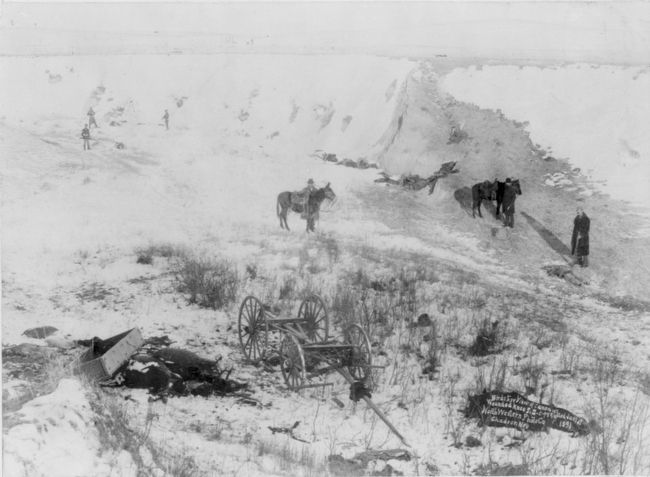Wounded Knee in Oglala Lakota County, South Dakota — The American Midwest (Upper Plains)
Massacre of Wounded Knee
Dec. 29, 1890, Chief Big Foot, with his Minneconjou and Hunkpapa Sioux Band of 108 warriors, 250 women and children were encamped on this Flat, surrounded by the U.S. 7th Cavalry (470 soldiers) commanded by Col. Forsythe.
The "Messiah Craze" possessed many Indians, who left the vicinity of Ind. Agencies to "Ghost Dance" during the summer and fall of 1890. "Unrest" on the Pine Ridge Reservation was partly due to the reduction of beef rations by Congress, and to the "Ghost Dancing" of Chiefs Sitting Bull, Hump, Big Foot, Kicking Bear, and Short Bull. The Sioux were told by Kicking Bear and Short Bull that by wearing "Ghost Shirts" the ghost dancing warriors would become immune to the whiteman's bullets and could openly defy the soldiers and White settlers, and bring back the old days of the big buffalo herds.
On Nov. 15, 1890, Indian Agent Royer (Lakota Wakakpaj) at Pine Ridge called for troops, and by Dec. 1, 1890, several thousand U.S. Regulars were assembled in this area of Dakota Territory.
On Dec. 15, 1890, Chief Sitting Bull was killed by Lt. Bullhead of the Standing Rock Indian Police. Forty of Sitting Bull's braves escaped from Grand River, and joined Chief Big Foot's band on Deep Creek to camp and "Ghost Dance" on the south fork of the Cheyenne River. Chief Big Foot was under close scrutiny of Lt. Col. Sumner and this troops, and on Dec. 23, 1890, they were ordered to arrest Big Foot as a hostile. However, the Big Foot band had already silently slipped away from the Cheyenne county, into the Badlands, heading for Pine Ridge.
On Dec. 28, 1890, without a struggle, Chief Big Foot surrendered to the U.S. 7th Cavalry (Maj. Whitesides) at the site marked by a sign five miles north of here. The Band was then escorted to Wounded Knee, camping that night under guard.
Reinforcements of the U.S. 7th Cavalry (including one company of Indian Scouts) arrived at Wounded Knee from Pine Ridge Agency the morning of Dec. 29, 1890. Col. Forsythe took command of a force of 470 men. A battery of four Hotchkiss guns was placed on the hill 400 feet west of here, overlooking the Indian encampment. Big Foot's Band was encircled at (OVER)
Reverse:
(Continued)
9:00 p.m. by a line of foot soldiers and cavalry. Chief Big Foot, sick with pneumonia, lay at a warmed tent provided by Col. Forsythe in the center of the camp. A white flag flew there, placed by the Indians. Directly in the rear of the Indian Camp was a dry draw, running east and west.
The Indians were ordered to surrender their arms before proceeding to Pine Ridge. Capt. Wallace, with an Army detail, began searching the teepees for hidden weapons. During this excitement, Yellow Bird, a medicine man, walked among the braves blowing on an eaglebone whistle, inciting the warriors to action, declaring that the "Ghost Shirt" worn by the warriors would protect them from the soldier's bullets. A shot was fired, and all hell broke loose. The troops fired a deadly volley into the Council warriors, killing nearly half of them. A bloody hand-to-hand struggle followed, all the more desperate since the Indians were armed mostly with clubs, knives and revolvers. The Hotchkiss guns fired 2-pound explosive shells on the groups, indiscriminately killing warriors, women, children and their own disarming soldiers. Soldiers were killed by cross-fire of their comrades in this desperate engagement.
Surviving Indians stampeded in wild disorder for the shelter of the draw 200 feet to the south, escaping west and east in the draw, and north down Wounded Knee Creek. Pursuit by the 7th Cavalry resulted in the killing of more men, women and children, causing the battle to be referred to as the "Wounded Knee Massacre". One hour later, 146 Indian, women and children lay dead in the Wounded Knee Creek valley. The bodies of many were scattered along a distance of two miles from the scene of the encounter. Twenty soldiers were killed on the field, and sixteen later died of wounds. Wounded soldiers and Indians alike were taken to Pine Ridge Agency. A blizzard came up. Four days later, an Army detail gathered up the Indian dead and buried them in a common grave at the top of the hill northwest of here. A monument marks this grave.
"Ghost Dancing" ended with this encounter. The Wounded Knee battlefield is the site of the last armed conflict between the Sioux Indians and the United States Army.
Topics. This historical marker is listed in these topic lists: Landmarks • Native Americans • Notable Events • Wars, US Indian. A significant historical date for this entry is December 29, 1890.
Location. 43° 8.991′ N, 102° 20.959′ W. Marker is in Wounded Knee, South Dakota, in Oglala Lakota County. Marker is on an unnamed extension off Big Foot Trail, 0.1 miles north of Big Foot Trail and Mouse Creek Road, in the median. The marker is on the Pine Ridge Indian Reservation. Touch for map. Marker is in this post office area: Batesland SD 57716, United States of America. Touch for directions.
Other nearby markers. At least 2 other markers are within 5 miles of this marker, measured as the crow flies. Chief Big Foot Massacre Monument (approx. 0.9 miles away); Chief Big Foot Surrenders (approx. 4.4 miles away).
More about this marker. The marker's title has apparently been altered. Initially, it read "'Battle' of Wounded Knee," and it shows signs of extensive vandalism over the years--bullet holes and other damage. Since the 1970s, the marker site has been the scene of American Indian Movement demonstrations and occasionally violent confrontations with federal authorities.
Regarding Massacre of Wounded Knee. Credits on the marker's bottom front read:
Delineator - Irving P. Pond and Herbert H. Clifford
By - Stanley S. Walker, Sup. Highway Engr.
Reprinted by Stacey and John Stewart, 5-5-95
Related marker. Click here for another marker that is related to this marker. To better understand the relationship, study each marker in the order shown.
Also see . . .
1. Pine Ridge Indian Reservation. Wikipedia entry (Submitted on April 12, 2008, by Richard E. Miller of Oxon Hill, Maryland.)
2. Wounded Knee Massacre. Wikipedia entry (Submitted on April 12, 2008, by Richard E. Miller of Oxon Hill, Maryland.)
3. Photos by Phil Konstantin, 2003. Includes pictures of the Wounded Knee Cemetery and various markers on the Pine Ridge Agency. (Submitted on April 12, 2008, by Richard E. Miller of Oxon Hill, Maryland.)
4. Wounded Knee Museum. Museum blog (Submitted on February 23, 2021, by Larry Gertner of New York, New York.)
Additional keywords. 9th U.S. Cavalry.
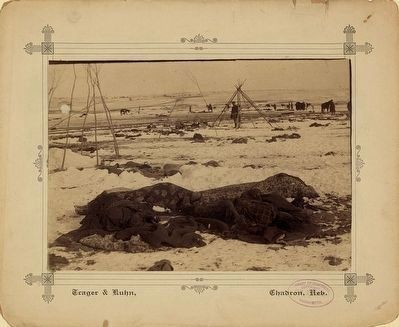
Photographed By Trager and Kuhn, 1891
6. Big Foot's camp three weeks after the Wounded Knee Massacre
Full title provided by the Library of Congress is: Big Foot's camp three weeks after the Wounded Knee Massacre (Dec. 29, 1890), with bodies of several Lakota Sioux people wrapped in blankets in the foreground and U.S. soldiers in the background.
Credits. This page was last revised on February 23, 2021. It was originally submitted on April 12, 2008, by Richard E. Miller of Oxon Hill, Maryland. This page has been viewed 7,207 times since then and 91 times this year. Last updated on March 4, 2011, by Richard E. Miller of Oxon Hill, Maryland. Photos: 1, 2. submitted on July 24, 2019, by Ruth VanSteenwyk of Aberdeen, South Dakota. 3. submitted on April 12, 2008, by Richard E. Miller of Oxon Hill, Maryland. 4. submitted on August 4, 2019, by Ruth VanSteenwyk of Aberdeen, South Dakota. 5, 6, 7, 8. submitted on November 24, 2015. • Kevin W. was the editor who published this page.
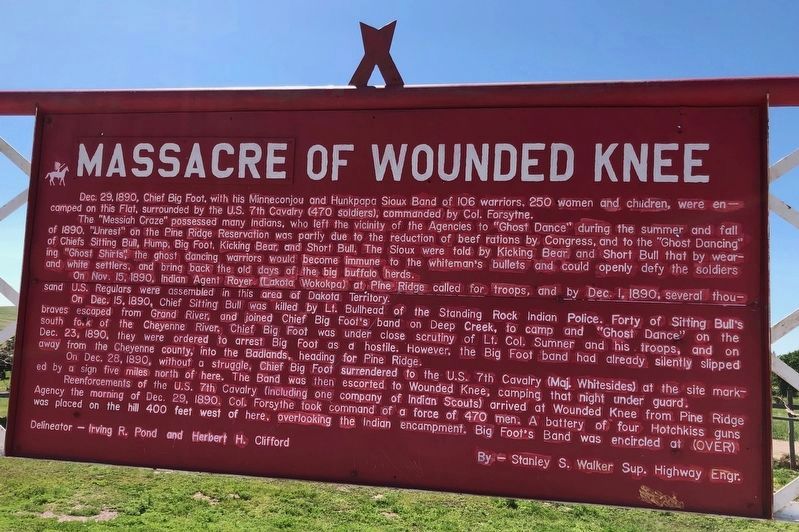
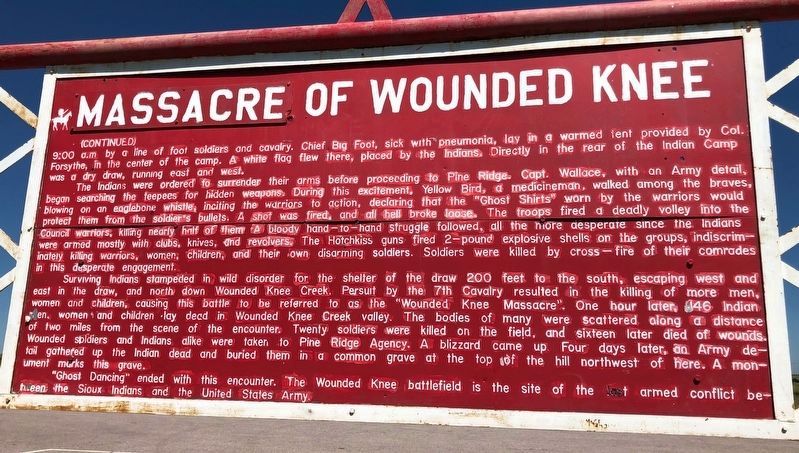
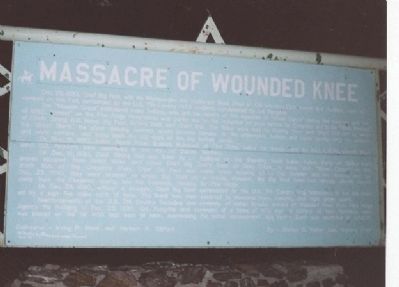
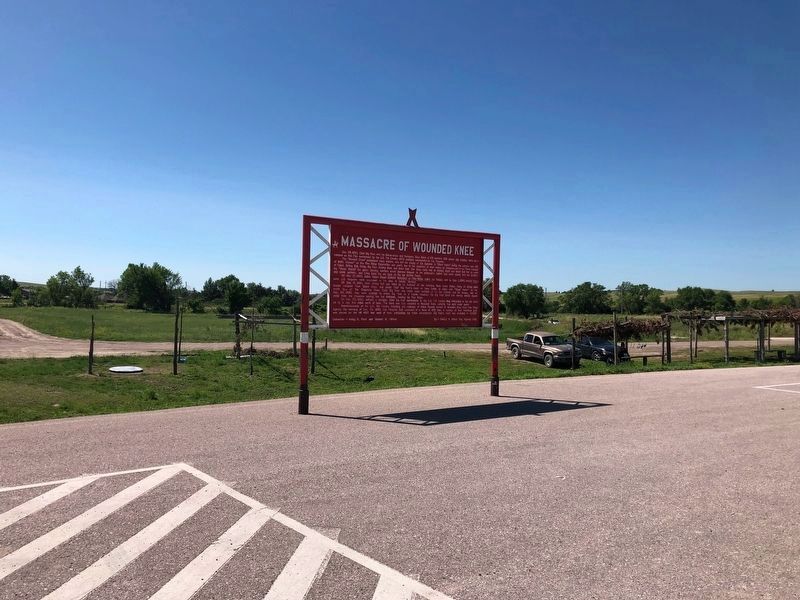
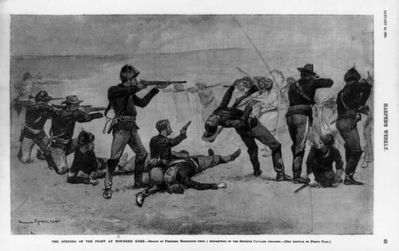
![<i>Big Foot, chief of the Bules [sic] taken at the Battle of Wounded Knee, S.D.</i>. Click for full size. <i>Big Foot, chief of the Bules [sic] taken at the Battle of Wounded Knee, S.D.</i> image. Click for full size.](Photos3/339/Photo339341.jpg?1124201530200AM)
